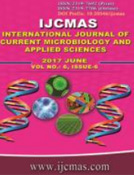


 National Academy of Agricultural Sciences (NAAS)
National Academy of Agricultural Sciences (NAAS)

|
PRINT ISSN : 2319-7692
Online ISSN : 2319-7706 Issues : 12 per year Publisher : Excellent Publishers Email : editorijcmas@gmail.com / submit@ijcmas.com Editor-in-chief: Dr.M.Prakash Index Copernicus ICV 2018: 95.39 NAAS RATING 2020: 5.38 |
Half diallel analysis of eight parents was carried out to identify the high heterotic crosses and their relationship in terms of general and specific combining ability (gca & sca) in Brassica juncea L. Czern and Coss. Mean squares due to parent v/s crosses were also significant for all the traits which depicted presence of heterosis for all the traits, except for days to maturity, plant height, siliquae on main shoot, number of seeds/siliqua, siliqua length and oil content in timely sown condition and for plant height, number of primary branches per plant, siliqua on main shoot and 1000 seed weight in late sown condition. The heritability in narrow-sense showed the prevalence of additive variance for siliqua length, days to maturity, number of primary branches per plant in late sown condition, while for other traits an appreciable proportion of total variance was non-additive in both the environments. In the present study, an overall appraisal of GCA effects revealed that RH0735 and BPR349-9 in normal environment and RH0116 and RH0555A in late sown environment were good general combiner for majority of the characters. High GCA effects are related to additive gene effects or additive x additive interaction which represent the fixable genetic component of variation. Hence these parents could be efficiently used for exploiting seed yield. For seed yield the crosses RH8814 x RH0555A, RH0644 x BPR543-3 and BPR349-9 x RH0644 in timely sown condition and crosses RH0555A x RH0644, RH0735 x RH0116 and BPR349-9 x RH0644 were identified as promising on the basis of their high per se performance and with high significant SCA effects. These crosses could be extensively used in breeding programme to develop superior segregants and the parents involved may be converted to well adapted cytoplasmic male sterile or restorer lines in further breeding programmes.
 |
 |
 |
 |
 |